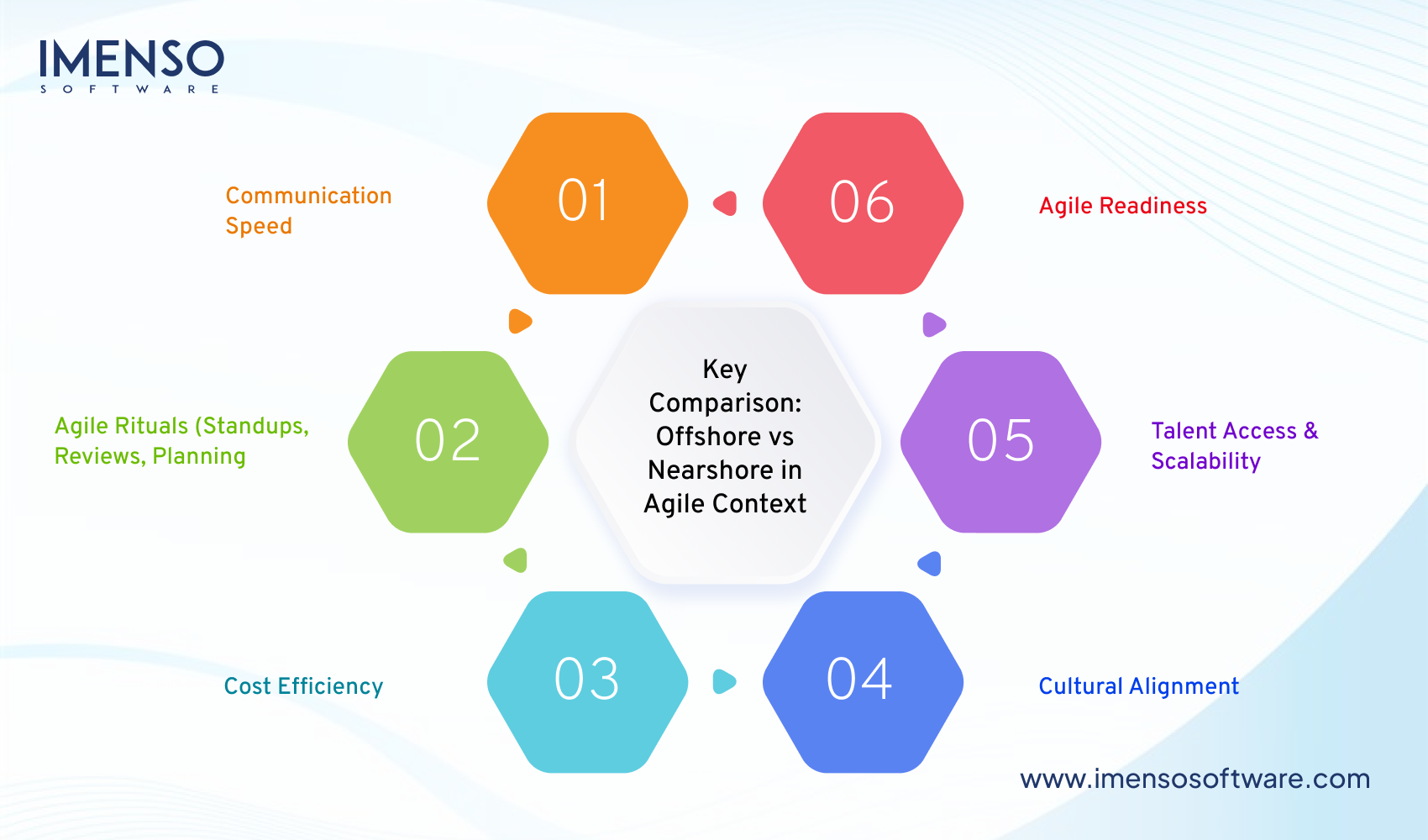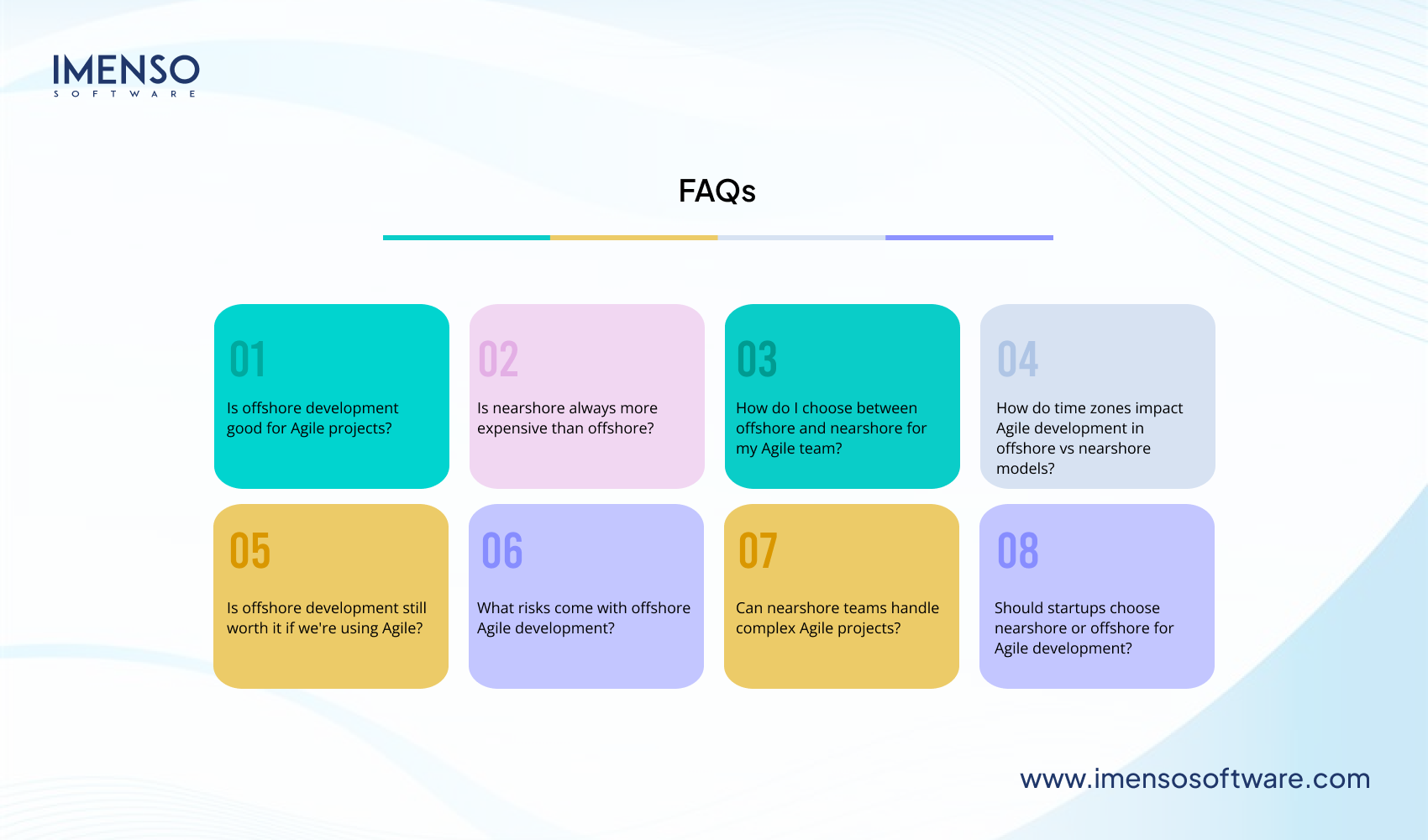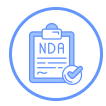Offshore vs. Nearshore: Which Delivery Model Is Best for Agile Development?

It’s not the strongest that survive nor the most intelligent, but the ones most responsive to change. ~ Charles Darwin
Do you know that adaptability isn’t a buzzword in Agile development? But it’s a foundation of success. The way you deliver your software can fuel that momentum or slow it to a crawl. So, make your team sprint like champions.
That’s where the big question comes in: Offshore or Nearshore? Although both delivery models offer global talent and cost efficiencies. Agile demands constant communication and a tight feedback along with cultural alignment. Hence, you need to work with the difference between time zones, and teamwork becomes huge.
Let’s unpack how each model stacks up in the world of Agile and find the better fit for your fast-moving development goals.
Understand the Basics
Are you aware of the offshore and nearshore development models? If not, let’s understand its fundamental elements.
What is Offshore Development?
This means outsourcing software development tasks to teams located in geographically distant countries or continents. These lower costs give access to global talent. Also, it is a great option for scalability.
But it comes with challenges:
- Major time zone differences
- Potential cultural misalignment
- Communication barriers
These can clash with Agile’s need for constant interaction.
What is Nearshore Development?
It involves outsourcing to neighboring or nearby countries, which usually have a 1–3 hour time difference. This offers:
- Better real-time collaboration
- Shared cultural norms
- Overlapping work hours
Thus, it is more agile-friendly. Although, this is possible at a slightly higher cost than offshore options.
3. Agile Development Needs
Agile development is a mindset that thrives on speed, flexibility, and tight collaboration and is not merely a project management style. That’s why your choice between offshore and nearshore delivery models can make or break your Agile execution.
What Agile Demands?
Agile values individuals and interactions over processes and tools. It encourages continuous delivery, face-to-face communication (even if virtual), and rapid feedback loops. For Agile teams to function efficiently, they need:-
- Fast communication between developers, testers, product owners, and stakeholders
- Overlap in working hours to conduct daily standups, sprint reviews, and planning sessions
- Cultural alignment to support transparency, collaboration, and ownership
- Quick pivots based on customer feedback or changing priorities
These needs highlight the importance of communication ease and minimal delays, two factors heavily influenced by geographic distance and time zones.
Why Time Zones and Communication Matter?
If your Agile team is working across a 10-hour time gap, even a quick bug fix or backlog clarification can take 24 hours to resolve. Multiply that over several sprints, and your velocity suffers.
On the flip side, when teams can hop on a call within minutes or sync during overlapping work hours, decisions happen faster, feedback is real-time, and productivity stays high, exactly what agile was designed for.
4. Offshore Delivery Model for Agile
The offshore development has long been a go-to for companies looking to scale quickly and cost-effectively. But how well does it fit with Agile’s fast-paced and collaboration-heavy approach?
Pros of Offshore for Agile
- Cost Efficiency: The biggest draw is the budget. That’s why, offshore teams can provide high-quality development at a fraction of the cost of local hires.
- Global Talent Pool: Outsourcing gives access to a vast pool of tech talent with expertise in everything from DevOps to mobile app development.
- Scalability: Need to scale your team fast? Offshore partners often have the resources to ramp up quickly without lengthy hiring cycles.
Cons of Offshore for Agile
- Time Zone Gaps: A 10+ hour difference means delayed communication and longer feedback loops. That slows down sprints and weakens Agile responsiveness.
- Communication Challenges: Language barriers and different communication styles can lead to misunderstandings in priorities and expectations.
- Cultural Misalignment: Agile thrives on ownership and proactivity. In some offshore settings, strict hierarchies or reluctance to challenge decisions can clash with Agile norms.
When Offshore Works Well in Agile?
Offshore can still support Agile with the right structure. It works best when:
- The project has well-documented user stories and minimal change
- Teams use overlapping hours (e.g., split shifts or adjusted work times)
- Strong tools (Slack, Jira, Zoom) and processes are in place to compensate for distance
- You invest in relationship-building to create trust and transparency
Real-World Example (Success)
Slack initially relied on an offshore team during early development. Their team in Canada collaborated with developers in the U.S. and Europe by using structured sprint planning, heavy documentation, and regular overlapping calls to maintain Agile momentum.
Real-World Example (Failure)
A U.S. retail startup tried offshore Agile with a team in Southeast Asia. Despite using Scrum, the 13-hour time gap led to delayed reviews and misaligned expectations. Features missed deadlines, communication broke down, and the team eventually had to reassign development to a nearshore partner.
Nearshore Delivery Model for Agile
Do you know the nearshore development offers a middle ground between cost savings and seamless collaboration? It offers better rhythm for sprint cycles for agile teams that rely on fast feedback, regular meetings, and high team engagement.
Pros of Nearshore for Agile
- Time Zone Alignment: These teams usually work within 1–3 hours of your local time. This makes it easier to hold daily standups and quick check-ins. You can also manage live demos.
- Real-Time Collaboration: With overlapping working hours, your team can resolve issues fast—no more waiting overnight for updates or bug fixes.
- Cultural Compatibility: Nearshore partners often share similar work ethics, business practices, and communication styles, which help Agile teams collaborate more effectively.
- Ease of Travel & Relationship Building: Face-to-face visits, team workshops, or sprint planning sessions are easier to organize with nearshore teams, strengthening trust and transparency.
Cons of Nearshore for Agile
- Higher Cost Compared to Offshore: While still more affordable than onshore development, nearshore services are usually more expensive than offshore alternatives.
- Smaller Talent Pools: Some nearshore regions may not offer the same volume of specialized talent as larger offshore hubs.
- Less 24/7 Development Coverage: Unlike offshore teams that can work while you sleep, nearshore teams usually operate during similar hours, limiting overnight progress.
When Nearshore Works Well in Agile?
Nearshore is often the best fit when:
- Your Agile process depends on real-time collaboration and fast iteration
- You need a flexible team that can evolve with changing sprint goals
- Your team values cultural alignment and clear communication
- You’re managing a high-stakes or high-speed product where delays are costly.
Real-World Example-1 (That Succeded)
Spotify has used nearshore teams in Eastern Europe to support Agile squads. With overlapping time zones and a shared Agile mindset, Spotify managed to maintain fast, iterative releases while tapping into niche engineering expertise near their headquarters.
Real-World Example-2 (That Failed)
A North American fintech firm partnered with a nearshore team in South America but failed to invest in Agile training or shared tools. Despite time zone alignment, the absence of synchronized Agile rituals and poor collaboration practices led to sprint delays and missed goals, proving that proximity alone isn’t enough.
Key Comparison: Offshore vs Nearshore in Agile Context
Every second counts when it comes to Agile, so the differences between offshore and nearshore delivery models aren’t more than just logistical. They directly affect how well your team can execute sprints, pivot fast, and deliver value continuously.
Here’s how offshore and nearshore stack up across Agile-critical dimensions:

1. Communication Speed
- Offshore: Expect delays due to non-overlapping hours. You might wait 12–24 hours for replies that will distract daily standups and sprint momentum.
- Nearshore: Real-time communication is much easier, allowing fast feedback, spontaneous calls, and smoother syncs between developers and product owners.
Better Choice: Nearshore
2. Agile Rituals (Standups, Reviews, Planning)
- Offshore: Requires extra coordination or asynchronous rituals, which can dilute the value of real-time collaboration.
- Nearshore: Smoother to schedule consistent Agile ceremonies during shared working hours.
Better Choice: Nearshore
3. Cost Efficiency
- Offshore: Considered cheaper and is ideal for companies with tight budgets or large development needs.
- Nearshore: More expensive than offshore, but still cheaper than hiring locally.
Better Choice: Offshore
4. Cultural Alignment
- Offshore: Cultural gaps can lead to misunderstandings and reluctance to speak up. It can also cause misinterpretation of Agile principles.
- Nearshore: Better cultural fit with Western teams that enhances team dynamics and Agile values like ownership and collaboration.
Better Choice: Nearshore
5. Talent Access & Scalability
- Offshore: Larger talent pool across more disciplines. Easy to scale up or down quickly.
- Nearshore: Smaller, but still strong—especially for full-stack dev, QA, and DevOps. May be slower to scale large teams.
Better Choice: Offshore
6. Agile Readiness
- Offshore: Some offshore firms are very Agile-mature, but this varies widely.
- Nearshore: Many nearshore partners specialize in Agile models and have engineers trained in Scrum, Kanban, and SAFe.
Better Choice: Nearshore
The Verdict?
If cost is your #1 concern and your Agile process is highly structured, offshore can work with the right setup. But if collaboration speed, culture, and flexibility are critical to your product’s success, nearshore gives Agile teams the edge they need to move fast without friction.
How to Choose the Right Model for Your Team?
So, nearshore excels in collaboration and speed, while offshore wins on cost and scale. But, the right model for your team depends on your unique priorities, stage of growth, and Agile maturity.
Here’s a framework to help guide the decision:-

1. Company Size & Stage
- Startups & fast-growing scale-ups often benefit more from nearshore due to the need for close collaboration, fast pivots, and evolving requirements.
- Established enterprises with structured workflows and robust documentation may find offshore a good fit, especially if they have the resources to manage across time zones.
For Startups → Nearshore
For Enterprises → Offshore or Hybrid
2. Budget Constraints
- Offshore will always offer a lower hourly rate, especially when If your primary driver is cost reduction,
- If you’re balancing cost with speed-to-market, nearshore can deliver faster outcomes, reducing overall project timelines and costs in the long run.
For Tight budget, long-term projects → Offshore
For Time-sensitive, iterative releases → Nearshore
3. Project Complexity
- For complex projects with evolving requirements and constant user feedback, Agile teams need real-time input and quick alignment—nearshore supports this better.
- For fixed-scope or well-documented projects, offshore can work with less day-to-day interaction.
For Evolving scope, complex UX → Nearshore
For Defined scope, minimal changes → Offshore
4. Agile Maturity
- If your internal team is new to Agile, nearshore partners can help co-navigate sprints, rituals, and retros with less friction.
- If your internal team is Agile-savvy, you may better manage the coordination overhead of an offshore team and still stay productive.
For New to Agile → Nearshore
For Agile-proficient team → Offshore or hybrid
5. Long-Term Collaboration
- Want to build a lasting, integrated team with a strong cultural fit? Nearshore wins.
- Looking for flexible staffing that you can scale up or down? Offshore partners usually have more resources.
For Long-term team building → Nearshore
For Scalable resourcing → Offshore
Pro TipMany companies find success with a hybrid model; using nearshore teams for Agile-heavy core development and offshore teams for support functions like testing, DevOps, or maintenance. |
Final Thoughts
Agile development thrives on speed, collaboration, and constant feedback. And also on the delivery model you choose can either empower that rhythm or slow it down.
- If you’re chasing cost efficiency and have the tools and maturity to manage across time zones, offshore can deliver big results.
- But if you need real-time collaboration, cultural fit, and Agile flexibility, nearshore is usually the smoother path to success.
In the end, it’s not just about location, it’s about alignment. Select the model that best fits your team’s working style, product goals, and customer expectations. Because in Agile, success isn’t just built in code, it’s built in communication!
FAQs

1. Is offshore development good for Agile projects?
Offshore development can work for Agile if you have mature processes and overlapping work hours along with strong communication tools. However, time zone delays and cultural gaps can reduce Agile effectiveness so, you will have to carefully manage them.
2. Is nearshore always more expensive than offshore?
Yes, nearshore typically costs more than offshore development—but often less than local/onshore teams. However, the time saved in communication and sprint efficiency can balance or even reduce total project cost.
3. How do I choose between offshore and nearshore for my Agile team?
Consider your priorities:
- Choose offshore if cost is your biggest concern and your team is Agile-experienced.
- Choose nearshore to ensure speed and communication along with real-time collaboration.
4. How do time zones impact Agile development in offshore vs nearshore models?
Agile relies on fast feedback loops. Offshore teams may face 8–12 hour delays in responses. This ultimately slows down sprints. Nearshore teams, work in similar hours which makes collaboration faster and smoother.
5. Is offshore development still worth it if we’re using Agile?
Yes, if your team is Agile-mature, has a structured sprint process, and can handle asynchronous communication. Offshore models work well for back-end tasks, QA, and well-defined projects.
6. What risks come with offshore Agile development?
- Delayed feedback due to time differences
- Miscommunication from language or cultural gaps
- Reduced agility if sprints require daily collaboration
Mitigating these risks requires tight planning, clear documentation, and overlap in working hours.
7. Can nearshore teams handle complex Agile projects?
Absolutely, nearshore teams often bring strong Agile expertise, and their ability to collaborate in real-time makes them ideal for projects with frequent iterations, changing priorities, or tight timelines.
8. Should startups choose nearshore or offshore for Agile development?
Startups benefit more from nearshore because they need speed, flexibility, and hands-on collaboration to pivot fast. Offshore can be risky for Agile unless you have strong in-house leadership and clearly defined tasks.
Want more information about our services?
Similar Posts

Monetize Your App Ideas by Partnering with Development Experts
Do you know that by 2025, the app economy is estimated to reach over 600 billion dollars? There are billions of smartphone users, so the requirement for app ideas is quite feasible. It is an app-dominated society which means there is little time or inclination when it comes to selecting the best app available. Some […]...

How to Vet a Software Development Partner: 11 Questions to Ask Before Signing!
Planning to partner for your software development projects? Well, if yes, you can’t afford to keep crucial aspects unaddressed. So, ensure that the other party is a suitable fit for you before finalizing any outsourcing software development contract with them. Do you know 68% of companies prefer to outsource to low-cost countries? Studies show that […]...

Google Cloud vs. AWS: A Comparison of Cloud Computing Services
Are you currently navigating the intricate cloud computing landscape, pondering which industry titan – Google Cloud or Amazon Web Services (AWS) – holds the key to unlocking your business’s true potential? Fear not, for we are here to guide you through this compelling journey of exploration and comparison. In today’s dynamic business environment, cloud computing […]...









